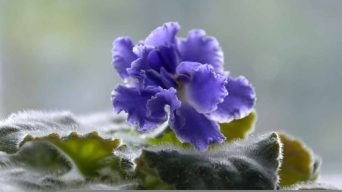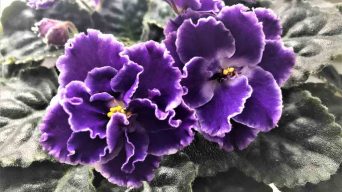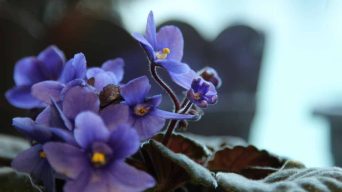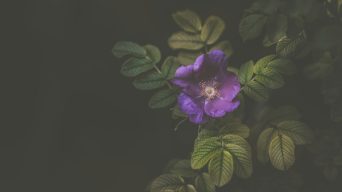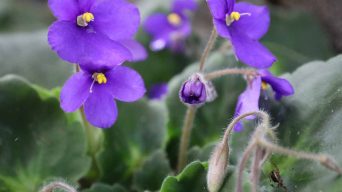African violets are delicate flowers that require extra care to stay healthy and bloom.
One problem you may encounter with your plant is brown spots on the leaves. These can be caused by several factors, including too much sun, water stress, or even pests.
Luckily, treating brown spots on African violets is relatively easy. Here are the most common causes of brown spots and how to treat them.
What Causes Brown Spots on African Violet Leaves and How to Treat Them
To treat brown spots on African violet leaves, you first need to identify the cause.
Here are some of the most common causes of brown leaf spots and how to treat them.
1. Too Much Sunlight
One of the main reasons brown spots appear on African violet leaves is that the plant is getting too much sunlight.
The leaves will turn brown and eventually get crispy and dry if they are in direct sunlight for too long.
African violets need bright, indirect light to thrive, and the leaves will suffer when exposed to too much sunlight.
You can tell if your plant is getting too much sun and if the leaves are starting to turn yellow or brown.
How To Treat Brown Spots Caused By Sunlight
If you think too much sunlight is causing brown spots on your African violet leaves, the best action is to move the plant to a place that gets less light.
African violets do best in bright, indirect light, so a spot near a window that doesn’t get direct sunlight would be ideal.
You can also use a sheer curtain to filter the light if you can’t move the plant.
2. Watering Issues
Watering issues are another common reason for brown spots on African violet leaves.
Incorrect watering can lead to several problems, including brown leaf spots.
The most common watering problems that cause brown spots are:
a. Underwatering
The leaves will turn brown and wilt if you don’t water your African violet plant enough.
This is because the plant needs to get more moisture to stay hydrated.
When the African violet is underwatered, it will draw moisture from the leaves, causing them to turn brown and wilt.
You can tell if your plant is dehydrated if the African violet leaves are drooping and the soil is dry.
How To Treat Brown Spots Caused By Underwatering
If you think that underwatering is causing brown spots on your African violet leaves, the best course of action is to water the plant more frequently.
Check the soil before watering to see if it’s dry.
If it is, water the plant until the soil is moist but not soggy.
Investing in a moisture meter to monitor the soil moisture levels and ensure your plant is getting enough water is also a good idea.
b. Overwatering
On the other hand, if you overwater your African violet, the leaves can also start to turn brown.
This is because the roots sit in water for too long and start to suffocate.
When the roots don’t have enough oxygen, they can’t absorb nutrients from the soil, leading to brown spots on the leaves.
If you’re overwatering your African violet, you can know if the leaves are yellow and mushy.
How To Treat Brown Spots Caused By Overwatering
If you think that overwatering is causing brown spots on your African violet leaves, the best course of action is to water the plant less frequently.
Allow the soil to dry out completely between watering sessions, and make sure the pot has drainage holes so the excess water can drain out.
Also, check the soil before watering to ensure it’s dry and not just moist.
3. Hard Water
Another common watering issue that causes brown spots is using hard water.
Hard water contains high levels of minerals, such as calcium and magnesium, which can build up on the leaves and eventually cause brown spots.
You can tell if your water is hard if there is a white, chalky residue on the leaves.
How To Treat Brown Spots Caused By Hard Water
If you think hard water is causing brown spots on your African violet leaves, the best action is to use distilled or filtered water.
You can also let tap water sit for 24 hours before using it so the minerals can settle at the bottom of the container.
Be sure to avoid using water softened with salt, which can also damage the leaves.
4. Fertilizer Burns
If you’re using too much fertilizer, or if the fertilizer you’re using is too strong, it can burn the leaves of your African violet. This will cause the leaves to turn brown and eventually die.
Using too much fertilizer can also build up in the soil and make it difficult for the roots to absorb water. This can lead to both brown spots on the leaves and root rot. You can tell if you’re using too much fertilizer if the leaves start to turn yellow before they turn brown.
How To Treat Brown Spots Caused By Fertilizer Burns
If you think that fertilizer burns are causing brown spots on your African violet leaves, the best course of action is to stop using fertilizer for a while.
Let the plant rest and allow the soil to flush out any excess fertilizer.
Once the plant has recovered, you can start fertilizing again, but use a weaker fertilizer and apply it less often.
Only fertilize your African violet when it’s actively growing, and never fertilize a dry plant.
5. Cold Damage
Cold damage is another common cause of brown spots on African violet leaves.
The leaves can turn brown and die if the temperature drops too low. African violets are tropical plants, and they thrive in warm temperatures.
They can tolerate a bit of cooler weather. Still, the leaves will suffer if the temperature drops below 60 degrees Fahrenheit.
If the plant is also exposed to drafts or cold winds, this can also cause the leaves to turn brown.
When the leaves turn brown and crispy, you can tell if your plant is experiencing cold damage.
How To Treat Brown Spots Caused By Cold Damage
If you think that cold damage is causing brown spots on your houseplant, the best action is to move the plant to a warmer location.
Avoid drafts or cold winds, and keep the temperature above 60 degrees Fahrenheit.
Place a heat lamp near the plant to give it some extra warmth.
6. Pest Infestation
Pests are another common problem that can cause brown spots on African violet leaves.
Aphids, mealybugs, and thrips are all common pests that attack African violets.
Aphids and mealybugs will suck the sap out of the leaves, causing them to turn yellow and brown.
Thrips will also feed on the leaves, but they also cause damage by scratching the surface of the leaves.
This damage can lead to brown spots and, eventually, leaf death.
You can tell if your plant has a pest infestation if you see small insects on the leaves or damage from insect feeding.
How To Treat Brown Spots Caused By Pest Infestation
If you think that pests are causing brown spots on your African violet leaves, treating the plant with insecticidal soap or neem oil is the best action.
Insecticidal soap will kill the pests on contact, and neem oil will repel them and prevent them from feeding.
Be sure to follow the instructions on the label and apply the treatment every few days until the pests are gone.
You can also control pests by maintaining a clean growing environment.
Clean up any dead leaves or debris that might be attracting pests.
Keep an eye out for new infestations and treat them as soon as possible.
7. Diseases
Several diseases can cause brown spots on African violet leaves.
The most common diseases that cause brown spots are:
Powdery Mildew
Powdery mildew is a fungal disease that attacks the leaves of African violets.
It causes a white, powdery mildew to form on the surface of the leaves.
The leaves will start to turn yellow and brown as the disease progresses.
Powdery mildew thrives in warm, humid conditions and can spread quickly from one plant to another.
You can tell if your plant has powdery mildew if you see a white, powdery substance on the leaves.
Bacterial Blight
Bacterial blight is another common disease that causes brown spots on African violet leaves.
A bacterial infection attacks the leaves, causing them to turn yellow and brown.
Bacterial blight is widespread in humid environments.
You can tell if your plant has bacterial blight if the leaves are yellow or brown and have small, dark spots on them.
The leaves may also be wilted or have a water-soaked appearance.
Leaf Spot
Leaf spot is a fungal disease that attacks the leaves of African violets.
It causes small, brown spots to form on the leaves.
The spots will get larger as the disease progresses and eventually turn yellow and brown.
Leaf spot is most common in humid climates.
You can tell if your plant has Leaf spot if the leaves have small, brown spots on them.
A yellow halo may surround the spots.
The spots will get larger as the disease progresses and eventually cover the entire leaf.
Rust
Rust is a fungal disease that affects African violets.
It causes small, orange-brown spots to form on the leaves.
The spots will get larger as the disease progresses and eventually turn yellow and brown.
You can tell if your plant has rust if you see small, orange-brown spots on the leaves.
Rust is most commonly found on the underside of the leaves.
How To Treat Brown Spots Caused By a Disease
If you think your plant has a disease, remove the affected leaves.
Cut off the leaves at the infected plant base and dispose of them.
Be sure to sterilize your scissors or knife before cutting off the leaves to prevent the disease from spreading.
You can also control diseases by maintaining a clean growing environment.
Keep your plant free of debris and dead leaves.
Water your plant from the bottom to prevent water from splashing on the leaves.
Be sure to provide good air circulation around your plant.
If the disease is severe, you may need to use a fungicide.
Be sure to follow the instructions on the label and apply the fungicide as directed.
8. Natural Aging
Brown spots can also appear on African violet leaves as the plant ages.
As the leaves age, they will eventually turn brown and die.
You can tell if your plant is starting to age if you see brown leaves.
If the spots are large and dark, it is a sign that the plant is getting old.
How To Prevent Brown Spots On African Violet Leaves
African violets are beautiful and popular indoor plants.
They are relatively easy to care for but can sometimes get brown spots on their leaves.
The best way to prevent this is by providing the plant with proper care.
Here are some tips on how to keep your African violet healthy and free from brown spots:
- Place the plant in a location that gets bright indirect sunlight. Too much direct sunlight can cause the leaves to scorch and turn brown.
- Water the plant properly. African violets should be watered from the bottom using lukewarm water. Allow the plant to soak up the water for a few minutes and drain any excess water.
- Don’t overwater the plant. African violets are susceptible to root rot, which can cause the leaves to turn brown. Be sure to only water the plant when the soil is dry.
- Water the soil, not the leaves. Avoid getting water on the leaves, as this can cause brown spots.
- Make sure the plant is getting enough humidity. African violets prefer humid conditions. The leaves can turn brown and crisp if the air is too dry.
- Protect the plant from drafty areas. African violets are sensitive to drafts, and their leaves can brown if exposed to too much air movement.
- Fertilize the plant regularly. African violets must be fertilized every two to four weeks during the growing season. Use a water-soluble fertilizer designed for African violets.
- Pruning the leaves. If the leaves of your African violet start to turn brown, you can try pruning them off. This will encourage new growth and help the plant to stay healthy.
- Monitor the plant for pests. African violets are susceptible to mealybugs, aphids, and other pests. These pests can cause the leaves to turn brown and die. Be sure to check your plant regularly for signs of pests.
Following these tips, you can help prevent brown spots on your African violet leaves.
If the problem persists, you may need to consult with a professional.
Final Thoughts
African violet care is easy once you get the hang of it.
Provide your plant with bright indirect light and water from the bottom only when the soil is dry to the touch, and you should have a happy and healthy plant.
If brown spots start to appear on the leaves, try one of the methods discussed in this article to get rid of them.
Remember to be patient and consistent with your treatment plan; soon enough, your plants will look as good as new.


